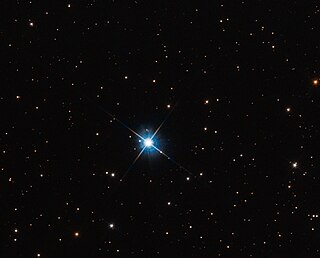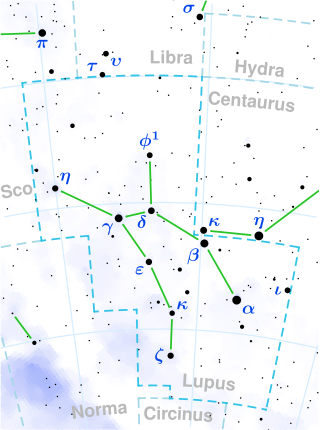Gliese 65, also known as Luyten 726-8, is a binary star system that is one of Earth's nearest neighbors, at 8.8 light-years from Earth in the constellation Cetus. The two component stars are both flare stars with the variable star designations BL Ceti and UV Ceti.
Gliese 1 is a red dwarf in the constellation Sculptor, which is found in the southern celestial hemisphere. It is one of the closest stars to the Sun, at a distance of 14.2 light years. Because of its proximity to the Earth it is a frequent object of study and much is known about its physical properties and composition. However, with an apparent magnitude of about 8.6 it is too faint to be seen with the naked eye.
Gliese 674(GJ 674) is a small red dwarf star with an exoplanetary companion in the southern constellation of Ara. It is too faint to be visible to the naked eye, having an apparent visual magnitude of 9.38 and an absolute magnitude of 11.09. The system is located at a distance of 14.8 light-years from the Sun based on parallax measurements, but is drifting closer with a radial velocity of −2.9 km/s. It is a candidate member of the 200 million year old Castor stream of co-moving stars.

Gliese 440, also known as LP 145-141 or LAWD 37, is an isolated white dwarf located 15.1 light-years from the Solar System in the constellation Musca. It is the fourth closest known white dwarf to the Sun
HIP 5158 is a star with a pair of orbiting substellar companions, located in the equatorial constellation of Cetus, the whale. It has the older designation CD-23 395, which is derived from the Cordoba Durchmusterung catalogue of southern stars. Based on parallax measurements, it is located 169 light years from the Sun. It has an absolute magnitude of 7.11, but at that distance the star has an apparent visual magnitude of 10.16, which is too dim to be visible to the naked eye. The system is receding with a radial velocity of 15.3 km/s, and it has a relatively high proper motion, traversing the celestial sphere at an angular rate of 0.205″·yr−1.

Stein 2051 is a nearby binary star system, containing a red dwarf and a degenerate star, located in constellation Camelopardalis at about 18 ly from Earth.
GJ 1062 is a single red dwarf star in the constellation Eridanus, positioned about two degrees to the SSE of Epsilon Eridani. It is also known as LHS 20 and Ross 578. The star is invisible to the naked eye with an apparent visual magnitude of +13.0, requiring a telescope with at least a 25 cm (10 in) aperture to view. It is located at a distance of 52.7 light years from the Sun based on parallax, but is drifting closer with a radial velocity of −85 km/s. The star has a high proper motion, traversing the sky at the rate of 3.033 arcseconds per year.
Gliese 180, is a small red dwarf star in the equatorial constellation of Eridanus. It is invisible to the naked eye with an apparent visual magnitude of 10.9. The star is located at a distance of 39 light years from the Sun based on parallax, and is drifting closer with a radial velocity of −14.6 km/s. It has a high proper motion, traversing the sky at the rate of 0.765 arcseconds per year.
GJ 3323 is a nearby single star located in the equatorial constellation Eridanus, about 0.4° to the northwest of the naked eye star Psi Eridani. It is invisible to the naked eye with an apparent visual magnitude 12.20. Parallax measurements give a distance estimate of 17.5 light-years from the Sun. It is drifting further away with a radial velocity of +42.3 km/s. Roughly 104,000 years ago, the star is believed to have come to within 7.34 ± 0.16 light-years of the Solar System.
Gliese 251, also known as HIP 33226 or HD 265866, is a star located about 18 light years away from the Solar System. Located in the constellation of Gemini, it is the nearest star in this constellation. It is located near the boundary with Auriga, 49 arcminutes away from the bright star Theta Geminorum; due to its apparent magnitude of +9.89 it cannot be observed with the naked eye. The closest star to Gliese 251 is QY Aurigae, which is located 3.5 light years away.
Gliese 205 is a nearby red dwarf star of spectral type M1.5, located in the constellation Orion at a distance of 18.6 light-years from Earth.
LP 816-60 is a single red dwarf star of spectral type M4, located in constellation Capricornus at 18.6 light-years from Earth.
Gliese 693 is a red dwarf star and a flare star of spectral type M2 located in the constellation Pavo, 18.95 light-years from Earth.
Gliese 784 is a single red dwarf star located in the southern constellation of Telescopium that may host an exoplanetary companion. The star was catalogued in 1900, when it was included in the Cordoba Durchmusterung (CD) by John M. Thome with the designation CD−45 13677. It is too faint to be viewed with the naked eye, having an apparent visual magnitude of 7.96. Gliese 784 is located at a distance of 20.1 light-years from the Sun as determined from parallax measurements, and is drifting closer with a radial velocity of −33.5 km/s. The system is predicted to come as close as 11.4 light-years in ~121,700 years time.
GJ 1128 is a red dwarf star of spectral type M4.0V, located in constellation Carina 21 light-years away from Earth. It is one of the closer stars to the Sun.
Gliese 54 is a star near the Solar System located at 25.7 light years away. It is located in the constellation of Tucana, close to the edge, almost in the neighboring Hydrus. It is below the threshold of brightness to be observable to the naked eye with an apparent magnitude of +9.80.

GL Virginis, also known as G 12-30, is a star in the constellation of Virgo. It is a faint red dwarf, like more than 70% of the stars located within 10 parsecs of the Solar System; its magnitude visual magnitude is 13.898, making it impossible to see with the naked eye.
Gliese 877 is a red dwarf located in the southern constellation of Octans, near the boundary with Indus.
Gliese 686 is a star in the constellation of Hercules, with an apparent magnitude +9.577. Although it is close to the Solar System – at 26.6 light-years – it is not the closest known star in its constellation, since Gliese 661 is 20.9 light years away. The closest system to this star is the bright μ Herculis, at 4.5 light years. They are followed by GJ 1230 and Gliese 673, at 7.2 and 7.6 light years respectively.



